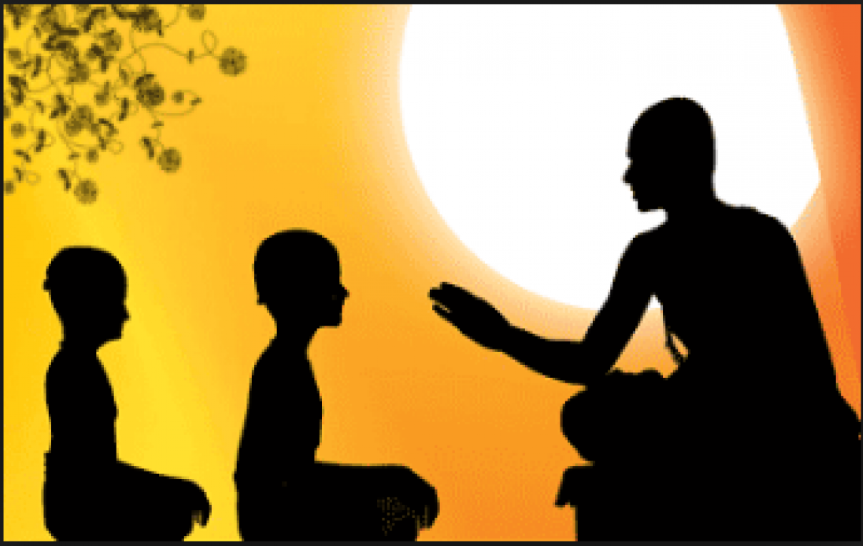The division of society into four orders called Varnas is not the only peculiar feature of Hindu Society. What is called Ashram Dharma is another. There is however one point of difference between the two. The Varna Dharma is a theory of the organization of society. The Ashram Dharma on the other hand is a theory of regulating the life of an individual.
The Ashram Dharma divides the life of an individual into four stages
(1) Brahmacharya, (2) Grahasthashram, (3) Vanaprastha and (4) Sannyas. The state of Brahmacharya has both de jure and de facto connotation in that it means an unmarried state of life. Its de jure connotation means the stage of study under a teacher. Grahasthashram is the stage of a householder, a stage of a married family life. The stage of Sannyas is a stage of renunciation of civic rights and responsibilities. It is a stage of civic death. The stage of Vanaprastha is in between Grahasthashram and Sannyas. It is a stage in which one belongs to society but is bound to live away from society. As the name implies it prescribes dwelling in forest.
The Hindus believe that this institution of Ashram Dharma is as vital as that of the Varna Dharma for the well-being society. They call the two by a joint name of Varnashram Dharma as though they were one and integral. The two together form the steel-frame of the Hindu Society.
To begin with it would be better to have a full understanding of the Ashram Dharma before inquiring into its origin and its purpose and its peculiarities. The best source for an exposition of the Ashram system is the Manu Smriti from which the following relevant extracts are reproduced:
“In the eighth year after conception, one should perform the initiation (upanayana) of a Brahmana, in the eleventh after conception (that) of a Kshatriya, but in the twelfth that of a Vaisya1.”
“A twice-born man who, not having studied the Veda, applies himself to other (and worldly study), soon falls, even while living, to the condition of a Sudra and his descendants (after him).”2
“The vow of the three Vedas under a teacher must be kept for thirty- six years or for half that time, or for a quarter, or until the (student) has perfectly learnt them.”
“Who has studied in due order the three Vedas, or two, or even one only, without breaking the (rule of) studentship, shall enter the order of householder.”3
“The student, the householder, the hermit, and the ascetic, these (constitute) four separate orders, which all spring from (the order of) householders.”
“But all (or) even (any of) these orders, assumed successively in accordance with the Institutes (of the sacred law), lead the Brahmana who acts by the preceding (rules) to the highest state.”
“And in accordance with the precepts of the Veda and of the Smriti, the housekeeper is declared to be superior to all of them; for he supports the other three4.”
“A Twice-born Snataka, who has thus lived according to the law in the order of householders, may, taking a firm resolution and keeping his organs in subjection, dwell in the forest, duly (observing the rules given below):
“When a householder sees his (skin) wrinkled and (his hair) white, and the sons of his sons, then he may resort to the forest5.”
“But having thus passed the third part of (a man’s natural term of) life in the forest, he may live as an ascetic during the fourth part of his existence, after abandoning all attachment to worldly objects.”
“He who after passing from order to order, after offering sacrifices and subduing his senses, becomes tired with (giving alms and offerings of food), as ascetic, gains bliss after death.”
“When he has paid the three debts, let him apply his mind to (the attainment of) final liberation; he who seeks it without having paid (his debts) sinks downwards.”
“Having studied the Vedas in accordance with the rule, having begot sons according to the sacred law, and having offered sacrifices according to his ability, he may direct his mind to (the attainment of) final liberation.”
“A twice-born man who seeks final liberation, without having studied the Vedas, without having begotten sons, and without having offered sacrifices, sinks downwards1.”
From these rules it is clear that according to Manu there are three features of the Ashram Dharma. First is that it is not open to Shudras and women. The second is Brahmacharya which is compulsory, so is Grahasthashram. Vanaprastha and Sannyas are not compulsory. The third is that one must pass from one stage to another in the order in which they stand namely first Brahmacharya, then Grahasthashram, then Vanaprastha and lastly Sannyas. No one can omit one and enter the next stage.
A cursory reflection on this system of stages which may well be called a system of planned economy of the life of the individual raises many questions. First is what forced Manu to have such a system of planned economy. Referring to the Vedas, the theory of stages in life is quite unknown. The Vedas speak of Brahmachari. But there is nothing to show that Brahmacharya was regarded as the first and inescapable stage in life. Why did the Brahmins make Brahmacharya as the compulsory stage in the life of an individual? This is the first riddle about the Ashram Dharma.
The second question is why Manu made it obligatory to observe the order of sequence in the following of the different stages of life by the individual. Now there is no doubt that there was a time when it was open to a Brahmachari to enter any of the three Ashrams! He may become a Grahasthashrami or he may at once become a Sannyasi without becoming a Grahasthashrami. Compare what the authors of the Dharma Sutras have to say on the point.
Vasistha Dharma Sutra2 says:
“There are four orders viz. (that of) the student, (that of) the householder, (that of) the hermit, and (that of) the ascetic”.
“A man who has studied one, two or three Vedas without violating the rules of studentship, may enter any of these (orders) whichsoever he pleases.”
Gautama Dharma Sutra3 says:
“Some (declare, that) he (who has studied the Veda) may make his choice
(which) among the orders (he is going to enter.)”
“The four orders are, (that of) the student (that of) the householder, (that) of the ascetic (bhikshu) (and that of) the hermit in the woods (Vaikhanasa).”
It is obvious from the views expressed by the Dharma Shastras that there was a time when the married state was an optional state. After Brahmacharya one would straight enter the stage of Vanaprastha or Sannyasa. Why did Manu remove the option and make the married state an obligatory state, why did he make the married state a condition precedent to the stage of hermit and the stage of hermit a condition precedent to the stage of a Sannyas?
After Grahasthashram there remain two stages to complete the round of life—Vanaprastha and Sannyas. The question is why Manu felt the necessity of life of the individual after Grahasthashram into two stages. Why was one stage of Sannyas not enough? The rules of regulating the life of the Vanaprastha and the Sannyasi as laid down in Manu are so alike that they give some point to the question.
In the following table a comparative study is made of the Codes for the Vanaprastha and the Sannyasa as prescribed by Manu:
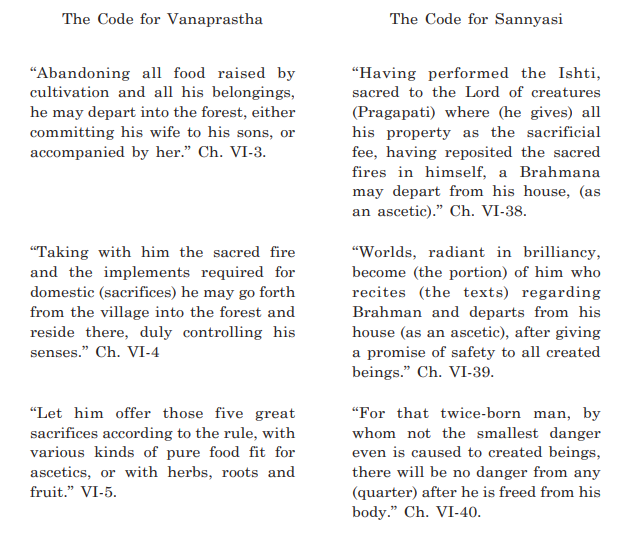
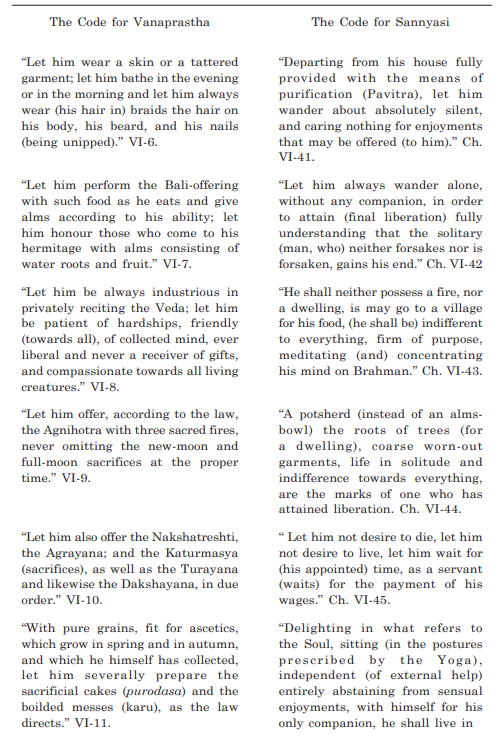
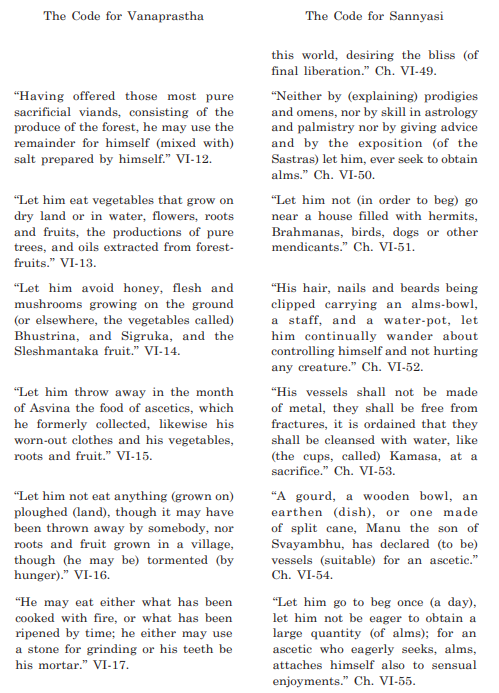
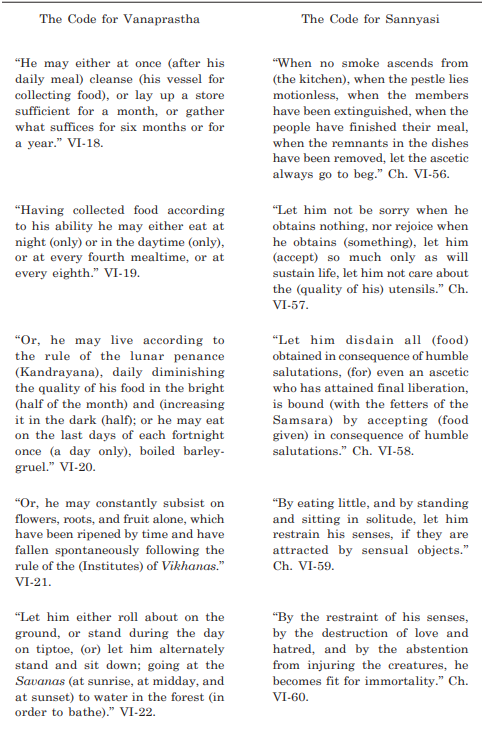
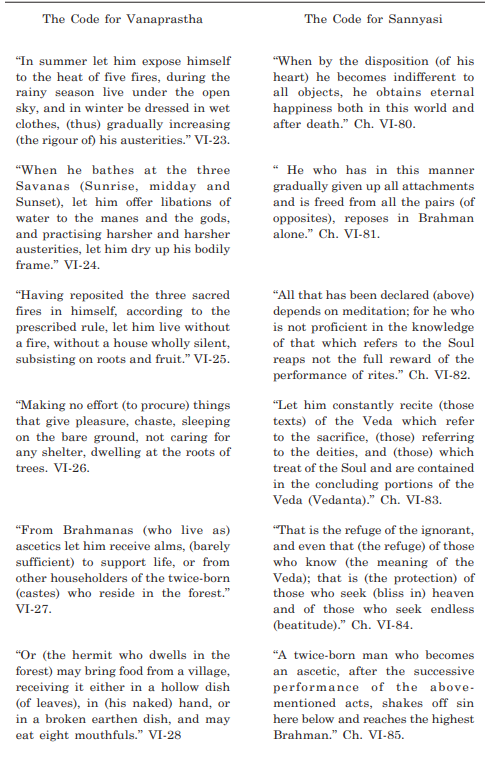
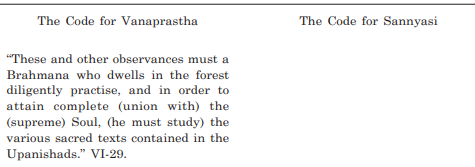
Comparing the Vanaprastha with Sannyas and Grahasthashram with Vanaprastha one sees some very striking resemblances between them. Comparing Vanaprastha with Sannyas there are only a few differences in the modes of life prescribed for them. Firstly a Vanaprastha does not abandon his wife or his rights over his property. But a Sannyasi must abandon both. Secondly, a Vanaprastha can have a fixed dwelling although it must be in a forest. But a Sannyasi cannot have a fixed dwelling not even in a forest. He must keep on wandering from place to place. Thirdly, a Sannyasi is debarred from expounding the Shastras while the Vanaprastha is not expressly placed under such a disability. As for the rest their mode of life is identical.
The resemblance between Grahasthashram and Vanaprastha is also very close. The Vanaprasthi is a Grahasthashrami for all essential purposes. Like the Grahasthashrami be continues to be a married man. Like, the Grahasthashrami he continues to be the owner of his property. Like the Grahasthashrami he does not renounce the world and like the Grahasthashrami he follows the Vedic religion. The only points of difference between the Vanaprasthi and the Grahasthashrami are three. (1) the Grahasthashrami is not bound to observe abstinence in his food and clothing to which a Vanaprasti is subject. (2) The Grahasthashrami dwells in the midst of society while the Vanaprasthi is required to live in a forest. (3) The Vanaprasti is free to study the Vedanta while the Grahasthashrami is confined to the study of the Vedas. As for the rest their modes of life are identical.
Having regard to these close resemblances between Grahasthashram and Vanaprastha and between Vanaprastha and Sannyas it is difficult to understand why Manu recognized this third ashram of Vanaprastha in between Grahasthashram and Sannyas as an ashram distinct and separate from both. As a matter of fact, there could be only three ashrams: (1) Brahmacharya, (2) Grahasthashram and (3) Sannyas. This seems to be also the view of Shankaracharya who in his Brahma Sutra in defending the validity of Sannyas against the Purva Mimansa School speaks only of three ashramas.
Where did Manu get this idea of Vanaprastha Ashram? What is his source? As has been pointed out above, Grahasthashram was not the next compulsory stage of life after Brahmacharya. A Brahmachari may at once become Sannyasi without entering the stage of Grahasthashram. But there was also another line of life which a Brahmachari who did not wish to marry immediately could adopt namely to become Aranas or Aranamanas1 . They were Brahmacharies who wish to continue the life of Study without marrying. These Aranas lived in hermitages in forests outside the villages or centres of population. The forests where these Arana ascetics lived were called Aranyas and the philosophical works of these aranas were called Aranyakas. It is obvious that Manu’s Vanaprastha is the original Arana with two differences (1) he has compelled Arana to enter the marital state and (2) the arana stage instead of being the second stage is prescribed as the third stage. The whole scheme of Manu rest in the principle that marriage is compulsory. A Brahmachari if he wishes to become a Sannyasi he must become a Vanaprastha and if he wishes to become a Vanaprastha he must become a Grasthashrami i.e., he must marry. Manu made escape from marriage impossible. Why?
This Article is taken from Babasaheb Ambedkar’s book Riddles in Hinduism

